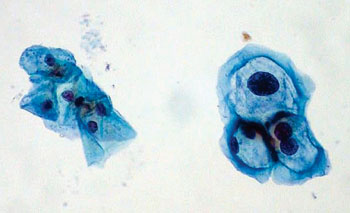Cervical Cancer Screening Could Become Less Frequent
By LabMedica International staff writers
Posted on 04 Nov 2016
Less-intensive screening is needed among women who have been vaccinated against human papillomavirus (HPV), which causes almost all cases of cervical cancer, because the risk of these women developing cervical cancer is quite low.Posted on 04 Nov 2016
Since 2012, major guideline-making organizations have recommended that all women in the USA be screened for cervical cancer every three years beginning at age 21 with a Papanicolaou test (Pap test), which checks for abnormal cells in the cervix, with the option of switching to a combination of Pap test and HPV testing (known as "co-testing") every five years beginning at age 30.

Image: A thin preparation pap smear with group of normal cervical cells on left and HPV-infected cells showing features typical of koilocytes: enlarged nuclei and hyperchromasia (Photo courtesy of Ed Uthman, MD).
Scientists at the Harvard T.H. Chan School of Public Health (Boston, MA, USA) developed a disease simulation model to estimate the risks and benefits of various screening protocols. Their model projected the health and economic effects of three different types of HPV vaccines that are currently approved for use, two of which have been available since 2006. The goal was to pinpoint screening strategies that would provide the biggest health benefit in the most cost-effective way. Cost-effectiveness analysis was conducted from the societal perspective to identify screening strategies that would be considered good value for money according to thresholds of USD 50,000 to USD 200,000 per quality-adjusted life-year (QALY) gained.
The team found that among women fully vaccinated with the bivalent or quadrivalent vaccine, optimal screening strategies involved either cytology or HPV testing alone every five years starting at age 25 or 30 years, with cost-effectiveness ratios ranging from USD 34,680 to USD 138,560 per QALY gained. Screening earlier or more frequently was either not cost-effective or associated with exceedingly high cost-effectiveness ratios. In women vaccinated with the nonavalent vaccine, only primary HPV testing was efficient, involving decreased frequency (i.e., every 10 years) starting at either age 35; with lower nonavalent vaccine efficacy, 10-year HPV testing starting at earlier ages of 25 or 30 years was optimal. Importantly, current USA guidelines for screening were inefficient in HPV-vaccinated women.
Jane J. Kim, PhD, a professor and lead author of the study, said, “This analysis enabled us to examine what would happen if we shifted from the current way we screen for cervical cancer - essentially, recommending the same type of screening for all women - to screening that takes into account whether women have been vaccinated against HPV and therefore face a substantially lower risk of cervical cancer. We found that continuing intensive screening among HPV-vaccinated women yields excessive costs and harms with little to no health benefit. ” The study was published on October 17, 2016, in the Journal of the National Cancer Institute.
Related Links:
Harvard T.H. Chan School of Public Health














